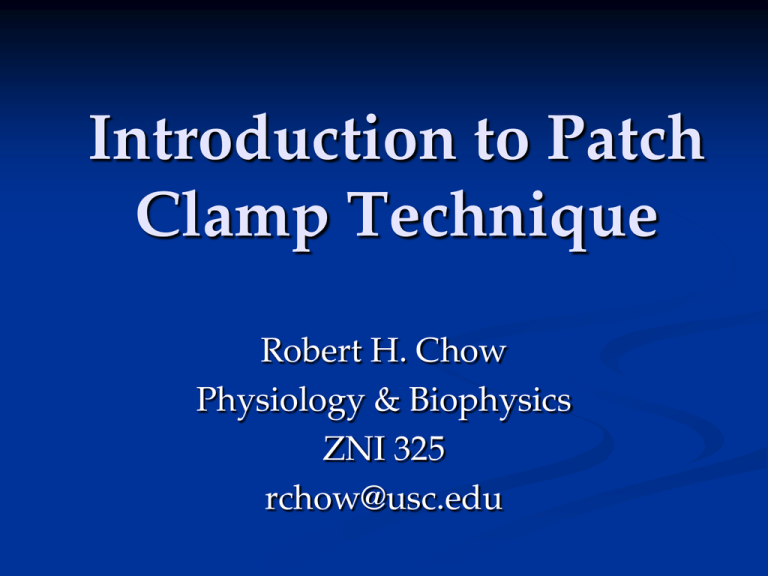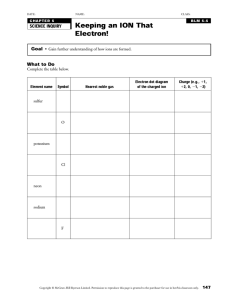Lecture 19
advertisement

Introduction to Patch Clamp Technique Robert H. Chow Physiology & Biophysics ZNI 325 rchow@usc.edu Transport Across Cell Membranes Cell Membrane Delimits cell boundary -> defines cell ~ 4-5 nm http://upload.wikimedia.org/wikipedia/commons/f/f0/Lipid_bilayer_section.gif Transport Across Cell Membranes Cell Membrane Membrane is relatively impermeable to charged molecules and ions Introduces challenge of how to bring things into and out of cell Transmembrane transporters Channels: ions, water, other Transporters (passive and active): glucose, amino acids, other Exocytosis/endocytosis Invention of Patch Clamp Technique Enabled measurement of ion currents through single channels Ion Channels Transmembrane proteins Gated pathway for ions to enter/exit cell History of channelology Concept: Hodgkin/Huxley (Nobel ‘70) Noise recordings, Katz (Nobel ‘72) Pore block/gating currents, Armstrong (Lasker ‘99) Size exclusion, Hille (Lasker ‘99) Single-channels, Neher & Sakmann (Nobel ‘91) Cloning, Numa Crystallization, Mackinnon (Lasker ‘99, Nobel ‘03) What is "patch clamp"? One of most powerful biophysical methods today Allows real-time monitoring of single protein behavior in cell membranes -- ionic channels Many other capabilities, too (see below) Nobel Prize in Physiology & Medicine to Neher & Sakmann, 1991 Patch Clamp Technique Hollow glass pipette Melted & pulled to produce tapering tip of diameter 1-3 µm Filled with electrolyte solution Mounted in special pipette holder on manipulator Pipette pressed gently against cell membrane Gentle suction applied to form “gigaseal” http://www.science-display.com/new/datenbank/detail.php?action=edit&id=23 Glass-membrane seal Note: shape Show pipette holder Modified from Sakmann and Neher, Sci. Am. 1991 Early Single-Channel Recording AChR in muscle Neher, Nobel Lecture cell-attached inside-out patch whole-cell outside-out patch Neher, Nobel Lecture Ion Channels Are Gated Pores That Are Selective For Transported Ions Ligand-gated ion channel Voltage-gated ion channel Note: All-or-none openings, stochastic From Ion Channels and Disease, Frances M. Ashcroft, Academic Press, 2000 Electrophysiology Conventions Current is plotted as positive (upward) for outward positive charge movement (or inward negative charge movement). Current is plotted as negative (downward) for inward positive charge movement (or outward negative charge movement). Channel Names Ligand-gated channels • Historically named after ligand e.g. Acetylcholine receptor/channels, glutamate receptor/channels Voltage-gated channels • Historically named after permeating ion e.g. Sodium channels, potassium channels, calcium channels Consensus names now based on DNA sequence Ion Channel Recordings Microscopic Ion currents through single channel or few channels Typically recorded using patch clamp with excised or isolated patch technique Macroscopic Ion currents through many channels typically recorded from entire cell or large membrane patch with microelectrode or patch clamp whole-cell technique Macroscopic Whole-cell Microscopic Single-channel Sakmann, Nobel Lecture Opening of voltage-gated ion channels is a stochastic process Hille, Ionic Channels of Excitable Membranes, 2nd ed., Sinauer Associates, 1992 Ion Channel Analysis Definitions Recall: Membrane potential Vm = yi-yo Vm = yi when yo = 0 Nernst Potential membrane potential at which membrane potential gradient = concentration gradient So, net current is zero for a given ion type at ~Nernst potential Ex=RT/ZF ln[x]o/[x]ί = 60 log10 [x]o/[x]ί How to study a specific ion channel type 1. 2. 3. 4. remove ions of other types increase concentration gradient of ion of interest toxins/drug blocker of other channels current enhancer of channel of interest Single-Channel Conductance AChR channel Step size (pA) Plot of current size as function of voltage Slope = I/V = conductance Sakmann, Nobel lecture i=γ(Vm-Ex) Ohms law for a single ion channel γ is single channel conductance and Vm-Ex = “Force” that drives ion movement micro i=γ(Vm-Ex) macro Im= npi Ion current through membrane Im , the whole cell current i , current through a single ion channel n , number of ion channels in membrane p , probability of ion channel being open γ , single channel conductance Ex , Nernst Potential Comparing Macroscopic and Single-Channel Recording Macroscopic Whole-cell Im= npi Microscopic Single-channel i=γ(Vm-Ex) Properties of Ion Channels 1 Gating and Selectivity Gating Unlike resistors, channels are open in an all-or-none fashion Gating triggered by one of the following Voltage change Chemical binding (e.g. transmitters) Mechanical force (e.g. stretch) Light Gating is stochastic Sakmann Nobel Lecture Voltage-dependent gating is based on movement of charges in the channel protein Bezanilla, 2000. Physiol. Rev. 80(2):556 http://www.anes.ucla.edu/%7Epancho/MODEL/SHKMODEL.HTML Bezanilla Model S4 rotates, moving + charges from crevice facing inwards to another crevice facing outwards 12 electron charges move in the process Movement of channel gates is seen as“gating current” Bezanilla, 2000. Physiol. Rev. 80(2):556 Ball-and-Chain Model of Inactivation Hille, Ionic Channels of Excitable Membranes, 2nd Ed., p. 356 & p. 357 Ashcroft, Ion Channels and Disease, p. 107 Ball-and-Chain Model of Inactivation Properties of Ion Channels 2 Selectivity Channels not passive conduits Interact specifically with permeating ions “Select” ions that can go through Yet, allow high throughput (~1e6 ions/s) Channels named based on ion selectivity e.g. Sodium channels, potassium channels, calcium channels, etc. Ion Channels as Molecular Sieves Li+ Na+ K+ Tl+ From Hille, Ionic Channels of Excitable Membranes, 2nd Ed., p. 356 & p. 357 Armstrong and Mackinnon on potassium channel ion selectivity mechanism ions K Na Optimal size Nonoptimal water “selectivity filter” Ion fully dehydrated Ion not fully dehydrated Net energy change = dehydration + coordination Xstall Structure 1 http://www.nature.com/nature/focus/ionchannel/ Xstall Structure 2 Fab fragments Red = Selectivity filter Mackinnon, Nature 2001 Green = K+ Red = water OTHER APPLICATIONS OF PATCH CLAMP 1. “sniffer patch” for monitoring transmitter release 2. “single-cell biochemistry”: control of intracellular composition introduction of chemicals/biological agents, etc. e.g. antibodies, metabolic poisons, protein fragments diffusional removal of intracellular contents e.g. to evaluate role of 2nd mess., specific proteins 3. single-cell molecular biology mRNA amplification & PCR 4. single-cell ionic/metabolic probes fluorescent dyes e.g. ion-sensitive dyes (FURA2, INDO, etc.) 5. Single-cell membrane capacitance measurements for exocytosis and endocytosis FURA-2: Example of calcium ion reporter Ratiometric dye, pathlength independent (Roger Tsien) Combined current and calcium measurement Macroscopic Whole-cell F390 F340 [Ca] Alternately excite at 390 and 340 nm While measuring fluorescence at ~510 nm Calculate free [Ca], based on ratio of F340/F390 (or other suitable wavelengths) Single Cell Biochemistry / Molecular Biology 1. Record/Image 2. RNA Processing 3. miRNA and cDNA profiling Cell Patch clamp e.g. membrane current or calcium measurement Total RNA extraction & amplification miRNA & cDNA microarrays Cell membrane is a capacitor () ee0 Cm = A d e = dielectric constant e0 = polarizabilty of free space d = membrane thickness Cells have lipid plasma membranes Lipids are insulators Cytoplasm and extracell fluid are electrolytes capacitance is proportional to the surface area of the insulator By measuring the capacitance we can measure the surface area of the cell. Specific membrane capacitance The proportionality factor is also called: specific membrane capacitance: 0.7-1µF/cm2 or 7 - 10 fF/µm2 cell (12µm diameter) = 3.6 pF (10-12 F) secretory granule (200 nm diameter) = 1 fF (10-15 F) synaptic vesicle (50 nm diameter) = 60 aF (10-18 F) Specific membrane capacitance is remarkably constant among different cell types and even different species. Why measure capacitance? Surface area increases upon exocytosis, due to addition of vesicle membrane to plasma membrane Monitoring surface area offers real-time assay of exocytosis Secretory cell ultrastructure: Secretory machine • Large Dense-Core Granules about 10 - 30,000 diameter ~350 nm Exocytosis: the Movie Science Magazine Cover 1993, vol. 258 From Molecular Cell Biology, 4th Ed., edited by Lodish et al. Whole-Cell Patch Clamp: Three-component model Frequency domain Sine wave stimulus Phase-sensitive Detector Y( t)= ReY( t)+ ImY( t) Ra Cm Rm Time domain Step function C=Q/V, Where Q= ∫ I dt Calculating Cm in Time Domain Vout If Rm >> Ra Ra Vcom Cm Rm Vcom Vm Im Vm Vcom Vm Recall Q=CV C = Q/V, where Q= ∫ I dt The Cm Response to 6 Depolarizations Black = control Red = complexin KO * p<0.05; ***p<0.00001 2 animals, 20 traces from 9 control cells 2 animals, 22 traces from 11 KO cells END

